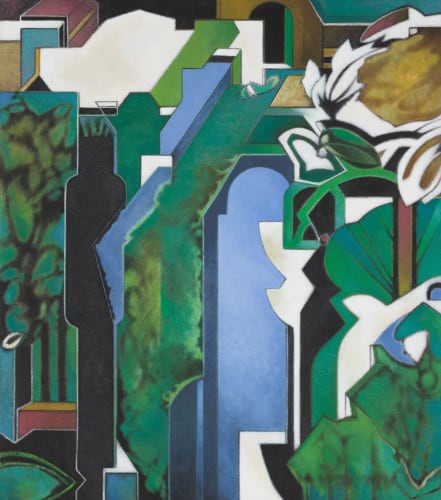To be held at The Gallery at Green and Stone
251-253 Fulham Rd., London SW3 6HY
One gets the sense that Olivia Stanton sees the world differently to most people. Where one person simply sees the edge of a roof, she sees a pleasing intersection of perpendicular forms. Instead of just a bird sitting on the branch of a tree, she sees the joyful curve of a wing and a ripple of light cast by sun and shadow on the leaves. The interplay of these shapes seep into her subconscious where, removed from their origins, they are free to shift and reshape so that when it comes to painting they are reborn as dynamic compositions of line, colour and form.
In association with Green & Stone, Candida Stevens Gallery is proud to present ‘Behind the Curve’, a solo show of works encapsulating the last four years of the artist’s practice. There is an uplifting confidence in this body of work reflective of the fact that Stanton has more time than ever to paint. A diverse colour palette, strong geometric shapes, sharp outlines and bold anchors of black come together in a series of works that feel both harmonious and empowered.
Working from her home with a raised view to the garden, the artist sits before her canvas and waits for the impulse to make her first mark. There is no plan or predetermined idea of what the final painting should look like, but that is not to say that the process is random. Instead, the positioning of each shape and colour is determined by the last in an unconscious and creative process in which Stanton guides the conversations emerging between the forms. Sometimes they refuse to talk to each other and she is forced to carry on, reworking the shapes again and again until she unearths the spark between them.
Not wanting to ascribe meaning through their names, Stanton often chooses the titles of her works based on the repeated phrases being used in the media at the time of making. There is a playfulness to the way she selects these. Track and Trace, 1-3, 2020, for example, dates three works to the pandemic but also invites the viewer to consider the lines within these pieces and follow them around each canvas. In doing so, we are taken on three very different journeys that demonstrate the transportive power of colour and command Stanton has over her palette.
Having worked for the iconic London art supply shop Green & Stone for almost fifty years, it is Stanton’s deep understanding of colour and technique that sits at the heart of her practice. Working exclusively in oils, she prepares her own canvases with traditional rabbit skin glue. Using this as a clear primer, she then paints ‘directly’ onto the pale, textured surface of the cotton. Over time, she has come to know which paints are vital in her armoury and how to mix them. Black, for example, is never just black. It is black mixed with a little blue or dash of red to achieve the unique tone that the painting demands. Choosing not to varnish her works, there is a vitality and honesty to the paintings that invites the viewer in.
Stanton absorbs the world around her, drawing inspiration from her surrounding environment in many forms; the purity of choral singing, for example, and raw quality of Marianne Faithfull’s voice, the directness of Paula Rego’s portraits and emotional charge of Francis Bacon’s work. In each, it is the honesty and directness of expression that excites the artist. She feels a close connection with artists who have been motivated by colour and form, citing British artists Robyn Denny and Gillian Ayres as major influences. Responding to abstract expressionism and reacting against the St Ives School of landscape painting that was dominant at the time, Denny and Ayres were at the forefront of a burgeoning movement towards abstraction in Britain that began in the late 1950s.
“To me, painting is a visual thing, and that’s it. People like to understand and I wish they wouldn’t! I wish they’d just look.” - Gillian Ayres OBE
Like Ayres, Stanton produces works that are not asking to be rationalised and understood, despite the glimpses of landscape they often contain. It can be tempting to try to ‘decipher’ the compositions, especially when these links to reality are apparent - a picket fence in the top left of Rollout, 1, 2021, for example, or a red building with black roof in the centre of Following the Science, 2021. There are rewards, however, for those who resist this urge and simply take the time to sink into the paintings and join the artist in enjoying the beauty of looking without looking. If we are able to achieve this, we arrive closer to understanding the essence of her work than any title ever could.
Olivia Stanton (b.1949) was born in Norfolk, England. Interested in art and writing, she secured a job at the Conway Library, Courtauld Institute of Art, in her early twenties. Here, she met influential figures such as Anthony Blunt and Sandy Nairne, and was inspired to train as an artist. Stanton trained at Byam Shaw School of Art (now part of Central Saint Martins), London from 1973-77 under the tutelage of Wynn Jones and Bill Jacklin. After almost a decade living in the foothills of the Pyrenees, France, she moved to Hastings, Sussex, in 2000, where she lives with her partner and fellow artist, David Henderson. She first started at Green & Stone as a student in 1973 and has worked with them for almost fifty years.
Isabella Joughin

